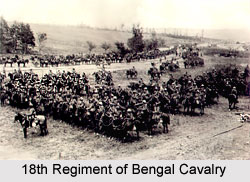 The 18th Regiment of Bengal Cavalry was an army cavalry regiment of the Bengal Army, under the British Indian Army. The unit remained in service from the year 1861 to 1922, after which it was merged with the regiment of 19th Lancers (Fane`s Horse) to form the 19th King George V`s Own Lancers unit. The Bengal Army was the armed forces of Bengal Presidency and was amongst the 3 main Presidency Armies in British India. The British Presidency Armies belonged to the British East India Company until the Sepoy Mutiny of 1857. In the year 1903, the 3 separate presidency armies were united to form the combined British Indian Army. The 18th Regiment of Bengal Cavalry was also known as the 18th King George`s Own Lancers or simply as the 18th Bengal Lancers.
The 18th Regiment of Bengal Cavalry was an army cavalry regiment of the Bengal Army, under the British Indian Army. The unit remained in service from the year 1861 to 1922, after which it was merged with the regiment of 19th Lancers (Fane`s Horse) to form the 19th King George V`s Own Lancers unit. The Bengal Army was the armed forces of Bengal Presidency and was amongst the 3 main Presidency Armies in British India. The British Presidency Armies belonged to the British East India Company until the Sepoy Mutiny of 1857. In the year 1903, the 3 separate presidency armies were united to form the combined British Indian Army. The 18th Regiment of Bengal Cavalry was also known as the 18th King George`s Own Lancers or simply as the 18th Bengal Lancers.
History of 18th Regiment of Bengal Cavalry
The 18th Regiment of Bengal Cavalry was formed as the 2nd Regiment of Mahratta Horse at Gwalior after the agitation of the Great Revolt of 1857, also known as the Sepoy Mutiny. Later the military unit was amalgamated with a small battalion of the Tiwana Horse regiment, which was an independent cavalry of Punjabi Muslims. Later in the year 1861, the regiment was re-named as the 18th Regiment of Bengal Cavalry and was again re-designated as the 18th Regiment of Bengal Lancers. The British Indian army unit participated in the Second Afghan War from the year 1879 to 1880. The cavalry also served in the Tirah Campaign on the North West Frontier of India in 1897.
In the year 1914, the 18th Regiment of Bengal Cavalry was posted in France during the First World War. It fought in the Battles of the Somme and Cambrai as well. The regiment was later sent to Egypt in 1918 and participated in General Allenby`s campaign in Palestine. The army command of the 18th Bengal Lancers also took part in the Battle of Megiddo.
After the culmination of World War I, the British Indian army decided to decrease the number of cavalry regiments by merging various military units together in pairs, instead of just dissolving the surplus regiments. As a result the whole cavalry line was re-designated and renumbered. The 18th Regiment of Bengal Cavalry was unified with the 19th Regiment of Bengal Cavalry (19th Fane`s Horse Lancers) regiment in order to raise the 18th/19th Cavalry in 1922. This regiment was renamed as the 19th King George`s Own Lancers in 1923 and later as 19th King George V`s Own Lancers in 1937.
Designations of 18th Regiment of Bengal Cavalry
The 18th Regiment of Bengal Cavalry was designated several times through the many restructuring and re-organisations in the British Indian Army. These are listed as follows-
* 18th Regiment of Bengal Cavalry - 1861
* 18th Regiment of Bengal Lancers - 1886
* 18th Bengal Lancers - 1901
* 18th Tiwana Lancers - 1903
* 18th Prince of Wales`s Own Tiwana Lancers - 1906
* 18th King George`s Own Lancers - 1910



















